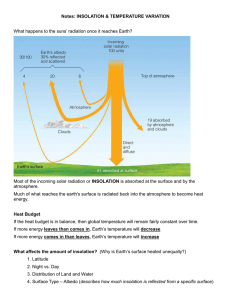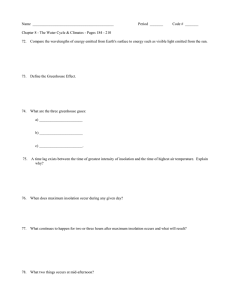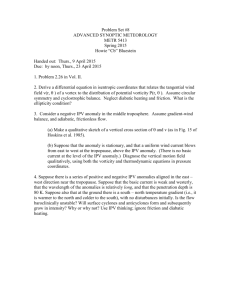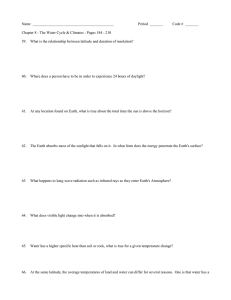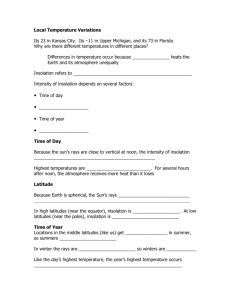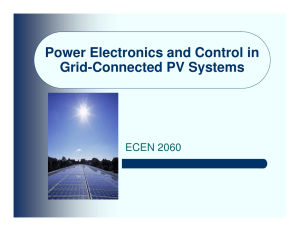PV Module Simulink models
advertisement
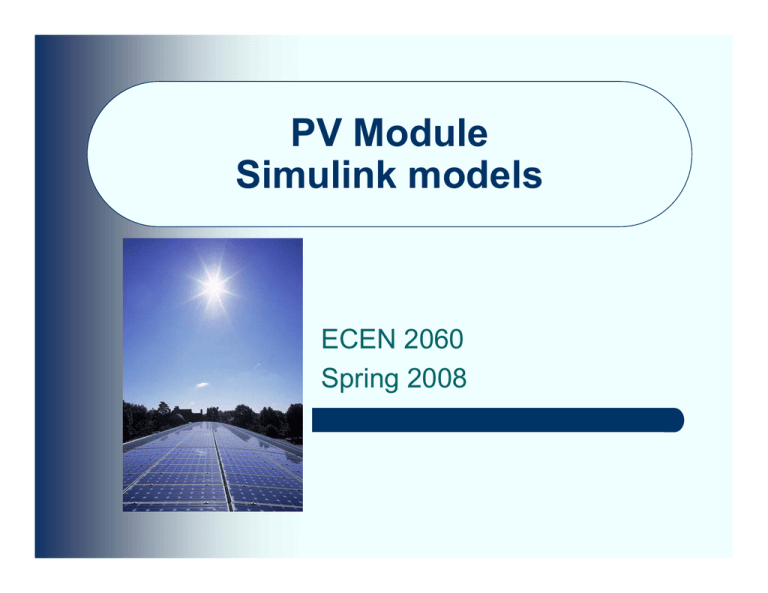
PV Module Simulink models ECEN 2060 Spring 2008 Simulink models of PV modules Current-input PV module Ipv PV module (I) Insolation Inputs: Voltage input PV module Vpv Vpv Insolation Ppv PV1 • PV current IPV [A] • Insolation [W/m2] Outputs: • PV voltage VPV [V] • PV output power Ppv [W] This model is well suited for the case when modules are connected in series and share the same current PV module (V) Inputs: Ipv Ppv PV1 • PV voltage VPV [V] • Insolation [W/m2] Outputs: • PV current IPV [A] • PV output power Ppv [W] This model is well suited for the case when modules are connected in parallel and share the same voltage Model parameters, in both cases, are the standard PV module data-sheet parameters: • short-circuit current Isc • open-circuit voltage Voc • rated current IR at maximum power point (MPP) • rated voltage VR at MPP under standard test conditions (1kW/m2, 1.5 AM, 25oC). A bypass diode (a single diode across the entire module) can be included. Temperature effects are not modeled. ECEN2060 2 PV cell circuit model and equations KCL: I SC ISC ID VD Rs + Rp Diode characteristic: _ PV cell VD − ID − − I PV = 0 Rp ( ) I D = I o eVD / VT − 1 KVL: VPVcell = VD − Rs I PV ECEN2060 3 Simulink Implementation • Both PV module models are implemented as masked subsystems in Simulink • Look Under Mask (right-click or Edit menu) reveals details of the model implementation PV module (I) • Details of the current-input PV module model: Ipv Vpv Insolation Ppv PV1 Saturation -Vt*log((u/Io)+1) max By-pass diode MinMax Rs 1 Ipv 2 Rs Ipv Product Ppv Diode Ipv Constant 2 Insolation G Isc Insolation to current gain Inputs: PV current and insolation ECEN2060 f (z) Solve f(z) = 0 z Vd Algebraic Constraint Id Io*(exp(u/Vt)-1) PN-junction characteristic Vd/Rp 1/Rp 1/Rp Vpv cell 1 Ns Switch Vpv Ns Outputs: PV voltage and PV power 4 Inside the current-input PV module model Saturation -Vt*log((u/Io)+1) max By-pass diode MinMax Rs 1 Ipv 2 Rs Ipv Product Ppv Diode Ipv Constant 2 G Insolation Isc Insolation to current gain f (z) Solve f(z) = 0 z Vd Vpv cell Algebraic Constraint Id Io*(exp(u/Vt)-1) Vd/Rp VPV = N sVPVcell 1/Rp N s = number of cells in series 1/Rp I SC KCL solved for VD using Algebraic Constraint block ECEN2060 Switch Vpv Ns PN-junction characteristic V − I D − D − I PV = 0 Rp 1 Ns VPVcell = VD − RS I PV ( ) I D = I o eVD / VT − 1 5 Inside the current-input PV module model Saturation 1 Ipv -Vt*log((u/Io)+1) max By-pass diode Bypass diode current cannot be negative MinMax Rs 2 Rs Ipv Product Ppv Diode Ipv Constant 2 Insolation G Insolation to current gain Isc f (z) Solve f(z) = 0 z Vd Algebraic Constraint Id Vpv cell 1 Ns Switch Vpv Ns Io*(exp(u/Vt)-1) PN-junction characteristic Vd/Rp 1/Rp 1/Rp I bypass + 1 VDbypass = Vt ln Io Select VPV with bypass diode (“Diode” = 1) or without bypass diode (“Diode” =0) Bypass diode voltage (if forward biased) ECEN2060 6 Model Mask: Parameters • Edit Mask (right-click or Edit menu), click on Parameters • This is where the masked subsystem model parameters are defined ECEN2060 7 Model Mask: Initialization • Edit Mask (right-click or Edit menu), click on Initialization • The MATLAB code computes model parameters Io, Rs, Rp based on the model parameters (short-circuit current Isc, circuit voltage Voc, rated voltage Vr, and rated current Ir) ECEN2060 8 Application Example: PV Array PV array consisting of 6 PV modules connected in series Ipv 1000 PV module (I) Insolation Vpv ECEN2060 6-module PV Array Ppv PV1 Insolation IPV Ipv PV module (I) Insolation Vpv Ppv PV2 + Ipv PV module (I) Insolation PV To Workspace Vpv Ppv Vpv PV3 Ipv PV module (I) Insolation VPV Vpv XY V-I Vpv Ppv PV4 Ppv Ppv Ipv PV module (I) Insolation Product Vpv Ppv PV5 Ipv PV module (I) Insolation _ XY power Vpv Ipv Simulink model pv_array.mdl Ppv PV6 Add Ipv Ramp Ipv ECEN2060 9 Inside the voltage-input PV module Vpv PV module (V) Insolation Ipv Ppv PV1 1 Vpv Ipv 2 Vpv Insolation Insolation Ppv f (z) Solve f(z) = 0 z Algebraic Constraint PV module (I) 1 Ipv 2 Ppv Inputs: PV voltage and insolation Current-input PV model ECEN2060 Algebraic Constraint block solves for IPV that results in VPV Outputs: PV voltage and PV power 10 Application Example: PV Module Characteristics Simulink model: pv_characteristic.mdl Vpv Vpv Vpv PV power Ipv Vpv PV module (V) Insolation Insolation I-V characteristic Ipv Ppv PV1 Insolation = 200, 400, 600, 800, 1000 W/m2 IPV ECEN2060 PPV VPV VPV 11
